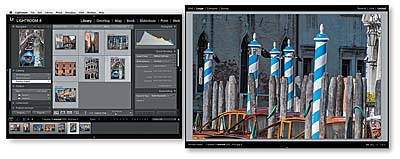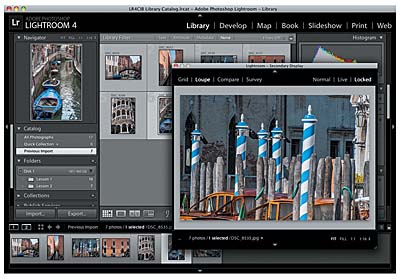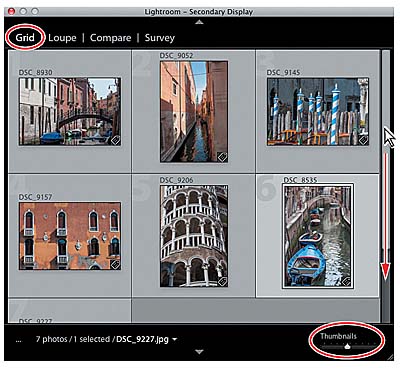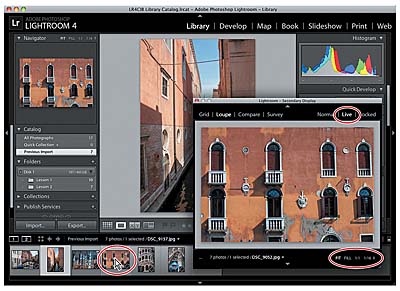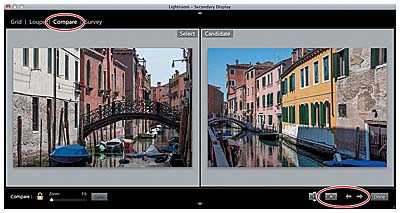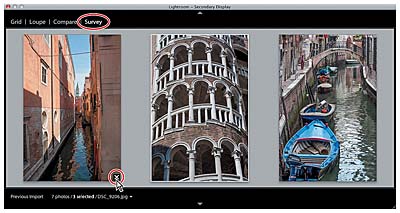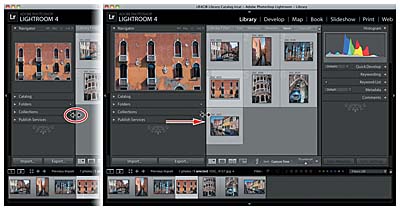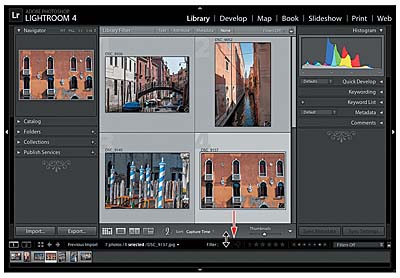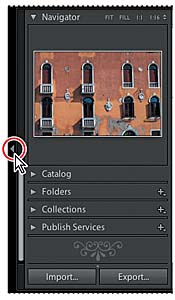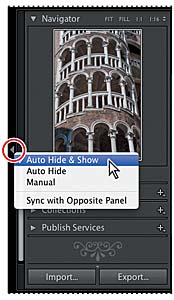- 2. Introducing the Workspace
- Toggling screen modes
- Adjusting the workspace layout
- Working with the left and right panel groups
- Working with the main display area
Adjusting the workspace layout
Working with the application window on Windows
In Normal screen mode on Windows, you can resize and reposition the application window just as you are used to doing with other applications.
- Move the pointer to any edge of the window. When the pointer changes to a horizontal or vertical double-arrow icon, you can drag the window’s edge.
- Move
the pointer to any corner of
the application window. When
the pointer changes to a diagonal
double-arrow (
 ),
you can drag the corner.
),
you can drag the corner. - Click
the Maximize button (
 ),
located beside the Close button
(x) at the right of the title
bar; the application window
expands to fill the entire
screen, though you are still
in Normal screen mode with
both the title bar and the
menu visible. While the window
is maximized, it’s no
longer possible to resize it
as you did in steps 1 and 2,
or reposition it by dragging
the title bar.
),
located beside the Close button
(x) at the right of the title
bar; the application window
expands to fill the entire
screen, though you are still
in Normal screen mode with
both the title bar and the
menu visible. While the window
is maximized, it’s no
longer possible to resize it
as you did in steps 1 and 2,
or reposition it by dragging
the title bar. - Click
the Restore Down button (
 )
to return to the previous window
size.
)
to return to the previous window
size.
Working with the application window on Mac OS
- In Normal screen mode on Mac OS, resize the application window by dragging its lower right corner.
- Click
the green Zoom button (
 ),
located beside the Close and
Minimize buttons at the left
of the title bar. The application
window expands to fill the
screen. Click the Zoom button
again to return to the previous
window size.
),
located beside the Close and
Minimize buttons at the left
of the title bar. The application
window expands to fill the
screen. Click the Zoom button
again to return to the previous
window size. - Reposition the application window on your screen by dragging the title bar.
Using a secondary display
If you have a second monitor connected to your computer, you can use it to display an additional view that is independent of the module and view mode currently active on your main monitor. You can choose between Grid, Loupe, Compare, and Survey views for your secondary display. You can choose to have the secondary view displayed in its own window that can be resized and repositioned, rather than have it fill your second screen.
If you have only one monitor connected to your computer, you can open the additional display in a floating window that you can resize and reposition as you work.
- To
open a separate window—whether
you’re using one or two
monitors—click
the Use Second Monitor / Show
Second Window button (
 ),
located at the upper left of
the Filmstrip.
),
located at the upper left of
the Filmstrip. - In the top panel of the secondary display, click Grid or press Shift+G.
- Use the Thumbnails slider in the lower right corner of the secondary display to change the size of the thumbnail images. Use the scrollbar on the right side, if necessary, to scroll to the end of the Grid view.
- In the secondary display, select an image from the grid, and then click Loupe in the top panel. Make sure that Normal is selected in the view mode picker at the right of the top panel.
- Use the left and right arrow keys on your keyboard to select either the previous or next photo in the Filmstrip. The new selection becomes the active image and the secondary display is updated accordingly.
- In the secondary display, click Live in the view mode picker at the right of the top panel.
- Select an image in the Filmstrip, and then click Locked in the view mode picker in the top panel of the secondary window. The current image will now remain fixed in the secondary display until you switch back to Normal or Live mode—regardless of the image displayed in the main window.
- Change the zoom level for the secondary display by choosing from the picker at the right of the lower panel: click Fit, Fill, or 1:1, or choose a zoom ratio from the menu at the far right.
- Drag the zoomed image to reposition it in the secondary window, and then click the image to return to the previous zoom level.
- (Optional) Right-click / Control-click the image to choose a different background color or texture from the context menu. These settings will apply to the secondary display independently of the options chosen for the main window.
- Choose Compare from the view picker in the top panel of the secondary window. In the main window, select two or more images—either in the Grid view or in the Filmstrip.
- In the main window, select three or more images—either in the Grid view or in the Filmstrip, and then click Survey in the top panel of the second window. Use the Survey view to compare more than two images at the same time (See illustration on next page). To remove an image from the Survey view, move the pointer over the unwanted image and click the Close button (x) that appears in the lower right corner of the image. You’ll learn more about the Compare and Survey views later in this book.
- Close
the secondary display by disabling
the menu option Window > Secondary
Display > Show,
or by clicking the Close button
(x) (Windows) / (
 )
(Mac OS).
)
(Mac OS).
The Grid view in the secondary display shows the same images as the Grid view and the Filmstrip in the main application window. The source indicator and menu on the left side of the lower panel work the same way as they do in the Filmstrip, and the top and bottom panels can be hidden and shown, just as they can in the main window. You’ll learn more about working with panels later in this lesson.
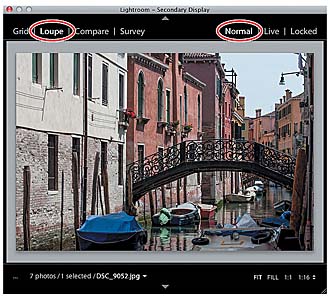
Figure 13 When the secondary display is in Normal mode, the Loupe view displays the active image from the Grid view and Filmstrip in the main display.
In Live mode, the secondary display shows the image that is currently under your pointer in either the Filmstrip, Grid, Loupe, Compare, or Survey view in the main window. You can set a different zoom level for the secondary display by choosing from the picker at the lower right of the secondary window.
The image in the left pane
of the Compare view is the Select image;
the image in the right pane
is the Candidate.
You can change the candidate
image by clicking the Select
Previous Photo button ( )
or the Select Next Photo button
(
)
or the Select Next Photo button
( ).
If you selected more than two
images, only images from the
selection are considered as
candidates. To replace the
Select image with the current
Candidate, click the Make Select
button (
).
If you selected more than two
images, only images from the
selection are considered as
candidates. To replace the
Select image with the current
Candidate, click the Make Select
button ( ).
).
Resizing panels
You can customize the layout of the Lightroom workspace to suit the way you work or make more space for the task at hand by adjusting the width of the side panel groups and the height of the Filmstrip panel, or by hiding any of these elements.
- Move the pointer over the right edge of the left panel group; the pointer changes to a horizontal double-arrow cursor. Drag to the right and release the mouse button when the panel group has reached its maximum width.
- Click Develop in the Module Picker to switch to the Develop module. You’ll notice that the left panel group returns to the width it was when you last used the Develop module.
- Press Alt+Ctrl+Up Arrow / Option+Command+Up Arrow to return quickly to the previous module.
- In the Library module, drag the right edge of the left panel group to return the group to its minimum width.
- Move the pointer over the top edge of the Filmstrip panel; the pointer changes to a vertical double-arrow cursor. Drag the top edge down until the Filmstrip reaches its minimum height.
- Switch to the Develop module. The Filmstrip remains unchanged as you move between modules. Whichever module you switch to, the Filmstrip will remain at its current height until you resize it.
- Move the pointer over the top edge of the Filmstrip panel; the pointer changes to a vertical double-arrow cursor. Double-click the top edge of the Filmstrip to reset the panel to its previous height; then switch back to the Library module.
- Drag the top border of the Filmstrip to its maximum height. The thumbnails in the Filmstrip are enlarged and, if necessary, a scrollbar appears along the bottom of the Filmstrip. Scroll to view all the thumbnails.
- Double-click the top edge of the Filmstrip with the vertical double-arrow cursor to reset the panel to its previous height.
The central work area contracts to accommodate the expanded panel group. You might use this arrangement to maximize the Navigator preview.
Lightroom remembers your customized workspace layout for each module independently, so that the workspace is automatically rearranged to suit the way you like to work for each stage in your workflow as you move between modules.
The work area expands to fill the available space. This arrangement increases the screen space available for the Grid view when you’re selecting photos, or for reviewing images in the Loupe, Compare and Survey views.
Showing and hiding panels or panel groups
As you’ve seen, one way of making more space for your work area is to resize the side panel groups and the Filmstrip. Another way is to completely hide panels from view. You can hide any of the panels surrounding the work area in the workspace. In some screen modes Lightroom even hides the title bar, the menu bar, and the Windows task bar or the Mac OS Dock.
- To
hide the left panel group,
click the Show / Hide Panel
Group icon (
 )
in the left margin of the workspace
window. The panel group disappears
and the arrow icon is reversed.
)
in the left margin of the workspace
window. The panel group disappears
and the arrow icon is reversed. - Click
the reversed Show / Hide Panel
Group icon (
 )
to reveal the left panel group.
)
to reveal the left panel group. - Disable the menu option Window > Panels > Show Left Module Panels or press the F7 key to hide the left panel group. To show the group again, press F7 or choose Window > Panels > Show Left Module Panels. Disable the menu option Window > Panels > Show Right Module Panels or press the F8 key to hide the right panel group. To show the group again, press F8 or choose Window > Panels > Show Right Module Panels.
- Disable the menu option Window > Panels > Show Module Picker or press the F5 key to hide the top panel. To show it again, press F5 or choose Window > Panels > Show Module Picker. To hide the Filmstrip, press the F6 key or disable the menu option Window > Panels > Show Filmstrip. To show it again, press F6 or choose Window > Panels > Show Filmstrip.
- To hide or show both side panel groups together, press the Tab key or choose Window > Panels > Toggle Side Panels. To hide or show the side panel groups, the top panel, and the Filmstrip together, press Shift+Tab, or choose Window > Panels > Toggle All Panels.
- Right-click
/ Control-click the Show /
Hide Panel Group icon (
 )
in the left margin of the workspace
window. Choose Auto Hide & Show
from the context menu.
)
in the left margin of the workspace
window. Choose Auto Hide & Show
from the context menu. - Hide
the left panel group by clicking
the Show / Hide Panel Group
icon (
 ).
Move the pointer over the icon,
or anywhere in the left margin
of the workspace. The left
panel group automatically slides
into view, partly covering
the work area. You can click
to select catalogs, folders,
and collections; the left panel
group will remain visible as
long as the pointer remains
over it. Move the pointer outside
the left panel group and it
will disappear again. To show
or hide the left panel group
regardless of the current panel
settings, press the F7 key.
).
Move the pointer over the icon,
or anywhere in the left margin
of the workspace. The left
panel group automatically slides
into view, partly covering
the work area. You can click
to select catalogs, folders,
and collections; the left panel
group will remain visible as
long as the pointer remains
over it. Move the pointer outside
the left panel group and it
will disappear again. To show
or hide the left panel group
regardless of the current panel
settings, press the F7 key. - Right-click
/ Control-click the Show /
Hide Panel Group icon (
 )
in the left margin of the workspace
window and choose Auto Hide
from the context menu. Now
the panel group disappears
when you are done with it and
does not reappear when you
move the pointer into the workspace
margin. To show the left panel
group again, click in the workspace
margin, or press the F7 key.
)
in the left margin of the workspace
window and choose Auto Hide
from the context menu. Now
the panel group disappears
when you are done with it and
does not reappear when you
move the pointer into the workspace
margin. To show the left panel
group again, click in the workspace
margin, or press the F7 key. - To
turn off automatic show and
hide, right-click / Control-click
the Show / Hide Panel Group
icon (
 )
in the left margin of the workspace
and choose Manual from the
context menu.
)
in the left margin of the workspace
and choose Manual from the
context menu. - To reset the left panel group to its default settings, activate Auto Hide & Show in the context menu. If necessary, press the F7 key or the F8 key to show the left and right panel groups.
You can use the arrows in the top, right, and bottom margins of the workspace to show and hide the top panel, the right panel group, and the Filmstrip.
Lightroom offers even more options for showing and hiding panels or panel groups; you can have them show and hide automatically in response to the movements of the pointer.
Keep it in mind that Lightroom remembers your customized panel layout for each module independently, including your preferred show and hide options, so you can set these options differently to suit the way you like to work in each module. The options you choose for the Filmstrip and the top panel, however, remain unchanged as you move between modules.
